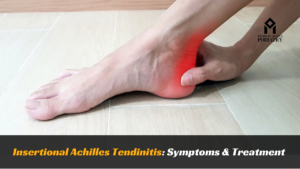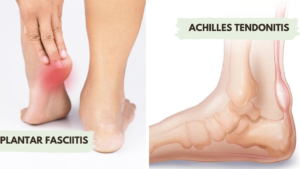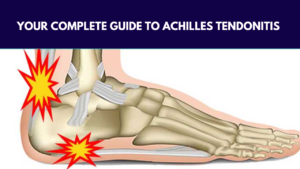Achilles tendinitis is a common condition that affects the Achilles tendon, the largest tendon in the body, responsible for connecting the calf muscles to the heel bone. It often occurs as a result of overuse, sudden increases in activity, or improper footwear, leading to inflammation, pain, and stiffness in the back of the heel. Recognizing the signs of Achilles tendinitis is crucial for early intervention and effective treatment. In this comprehensive guide, we’ll explore the symptoms, causes, treatment options, and the importance of consulting a podiatrist or foot doctor for proper diagnosis and care.
Understanding Achilles Tendinitis
Achilles tendinitis occurs when the Achilles tendon becomes inflamed or irritated due to repetitive stress or strain. This can occur from activities such as running, jumping, or sudden changes in physical activity level. Over time, excessive stress on the tendon can lead to microtears and degeneration, contributing to pain and dysfunction in the affected area.
Signs and Symptoms of Achilles Tendinitis
- Pain and Stiffness: The hallmark symptom of Achilles tendinitis is pain and stiffness in the back of the heel or lower calf. The pain may be mild to moderate initially but can worsen with activity or prolonged periods of rest.
- Tenderness: The area around the Achilles tendon may feel tender to the touch, especially when pressure is applied or during palpation.
- Swelling and Inflammation: Inflammation and swelling may be present in the Achilles tendon, resulting in localized swelling and warmth around the affected area.
- Morning Stiffness: Many individuals with Achilles tendinitis experience stiffness and discomfort in the morning upon waking, which may improve with gentle stretching and movement.
- Reduced Range of Motion: As the condition progresses, you may notice a decrease in flexibility and range of motion in the ankle joint, making activities like walking or climbing stairs more challenging.
- Crepitus: In severe cases, crepitus or a crackling sensation may be felt when moving the ankle joint, indicating degenerative changes within the tendon.
Causes of Achilles Tendinitis
Several factors can contribute to the development of Achilles tendinitis, including:
- Overuse or repetitive stress on the Achilles tendon from activities such as running, jumping, or sports that involve sudden stops and starts.
- Tight calf muscles or inadequate stretching before physical activity, leading to increased strain on the Achilles tendon.
- Improper footwear or worn-out shoes that fail to provide adequate support or cushioning for the feet and ankles.
- Biomechanical issues such as flat feet, high arches, or abnormal foot mechanics that alter the distribution of forces along the Achilles tendon.
Treatment Options for Achilles Tendinitis
- Rest and Activity Modification: Resting the affected leg and avoiding activities that exacerbate symptoms are essential for allowing the tendon to heal. Low-impact activities such as swimming or cycling may be recommended as alternatives to high-impact exercises.
- Ice Therapy: Applying ice packs to the affected area for 15-20 minutes several times a day can help reduce pain, inflammation, and swelling.
- Stretching and Strengthening Exercises: Gentle stretching exercises for the calf muscles and Achilles tendon can improve flexibility and reduce tension. Strengthening exercises focusing on the calf muscles and ankle stabilizers can help support the tendon and prevent recurrence.
- Orthotic Inserts: Custom orthotic inserts or heel lifts may be prescribed to provide additional support, cushioning, and alignment correction for individuals with biomechanical issues or abnormal foot mechanics.
- Medications: Over-the-counter nonsteroidal anti-inflammatory drugs (NSAIDs) such as ibuprofen or naproxen may be recommended to alleviate pain and inflammation. In some cases, corticosteroid injections may be administered to reduce inflammation and pain in the affected area.
- Physical Therapy: A structured physical therapy program supervised by a qualified therapist can help improve strength, flexibility, and biomechanics, facilitating a safe return to physical activity.
- Extracorporeal Shockwave Therapy (ESWT): ESWT is a non-invasive treatment modality that uses shockwaves to stimulate healing and reduce pain in the Achilles tendon.
- Surgery: In severe cases of Achilles tendinitis or when conservative treatments fail to provide relief, surgical intervention may be considered. Surgical options may include tendon debridement, tendon repair, or lengthening procedures.
Consulting a Podiatrist or Foot Doctor
If you’re experiencing symptoms of Achilles tendinitis, it’s essential to seek prompt evaluation and treatment from a podiatrist or foot doctor. A podiatrist can perform a comprehensive examination, including a review of your medical history, physical assessment, and diagnostic tests such as ultrasound or MRI, to accurately diagnose the condition and develop an individualized treatment plan tailored to your needs.
Conclusion
Achilles tendinitis can significantly impact your mobility, comfort, and quality of life if left untreated. By recognizing the signs and symptoms of Achilles tendinitis and seeking timely intervention from a podiatrist or foot doctor, you can effectively manage the condition and prevent long-term complications. With a comprehensive treatment approach involving rest, rehabilitation, and proper footwear, you can regain mobility, alleviate pain, and return to the activities you love with confidence.




